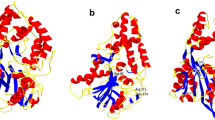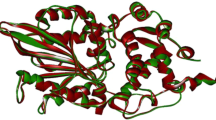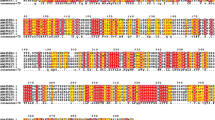Abstract
Through alignment of amino acid sequences among different phytases, we found that the amino acid at residues 53 and 91 vary broadly. To prove that the amino acid at residues 53 and 91 were related to phytase specific activity, two single mutant phyI1s Q53R and K91D were obtained by site-directed mutagenesis strategy. None of the single amino acid residues in the two mutants was in a position reported to be important for catalysis or substrate binding. Kinetic analysis of the phytase activity of the two mutants (Q53R and K91D) indicated that the mutants were attributed to 2.2- and 1.5-fold increased specific activity, and a 1.47- and 1.16-fold increased affinity for sodium phytate. In addition, the overall catalytic efficiency (k cat/K m) of the two mutants was improved 4.08- and 2.84-fold compared to that of the wild type. Such mutants will be instrumental for the structure–function study of the enzyme and for industrial application.



Similar content being viewed by others
References
Wodzinski RJ, Ullah AH (1996) Phytase. Adv Appl Microbiol 42:263–302
Ullah AH, Gibson DM (1987) Extracellular phytase (E.C.3.1.3.8) from Aspergillus ficuum NRRL 3135: purification and characterization. Prep Biochem 17:63–91
Mitchell DB, Vogel K, Weimann B, Pasamontes L, Loon APGM (1997) The phytase subfamily of histidine acid phosphatases: isolation of genes for two novel phytases from the fungi Aspergillus terreus and Myceliophthora thermophola. Microbiology 143:245–252
Oh BC, Choi WC, Park S, Yo Kim, Oh TK (2004) Biochemical properties and substrate specificities of alkaline and histidine acid phytases. Appl Microbiol Biotechnol 63:362–372
Common FH (1989) Biological availability of phosphorus for pigs. Nature 143:370–380
Bakul DM, Sonali PJ, Steven CJ, Pushpalatha PN (2006) Lily pollen alkaline phytase is a histidine phosphatase similar to mammalian multiple inositol polyphosphate phosphatase (MINPP). Phytochemistry 67:1874–1886
Gibson DM, Ullah AH (1988) Purification and characterization of phytase from cotyledons of germinating soybean seeds. Arch Biochem Biophys 260:503–513
Choi YM, Suh HJ, Kim JM (2001) Purification and properties of extracellular phytase from Bacillus sp. KHU-10. J Protein Chem 20:287–292
Kerovuo J, Lauraeus M, Nurminen P, Kalkkinen N, Apajalahti J (1998) Isolation, characterization, molecular genecloning, and sequencing of a novel phytase from Bacillus subtilis. Appl Environ Microbiol 64:2079–2085
Rodriguez E, Han Y, Lei XG (1999) Cloning, sequencing, and expression of an Escherichia coli acid phosphatase/phytase gene (appA2) isolated from pig colon. Biochem Biophys Res Commun 257:117–123
Xiong AS, Yao QH (2004) Isolation, characterization, molecular cloning of the cDNA encoding a novel phytase from Aspergillus niger 113 and high expression in Pichia pastoris. BMB Rep 37:282–291
Wyss M, Pasamontes L, Friedlein A, Remy R, Tessier M, Kronenberger A, Middendorf A, Lehmann M (1999) Biophysical characterization of fungal phytases (myo-inositol hexakis phosphate phosphohydrolases): molecular size, glycosylation pattern, and engineering of proteolytic resistance. Appl Environ Microbiol 65:359–366
Tomschy A, Tessier M (2000) Optimization of the catalytic properties of Aspergillus fumigatus phytase based on the three-dimensional structure. Protein Sci 9:1304–1311
Tomschy A, Wyss M, Kostrewa D, Vogel K (2000) Active site residue 297 of Aspergillus niger phytase critically a!ects the catalytic properties. FEBS Lett 472:169–172
Kim T, Mullaney EJ (2006) Shifting the pH profile of Aspergillus niger PhyA phytase to match the stomach pH enhances its effectiveness as an animal feed additive. Appl Environ Microbiol 72:4397–4403
Xiong AS, Yao QH, Peng RH, Duan H, Li X, Fan HQ, Cheng ZM, Li Y (2006) PCR-based accurate synthesis of long DNA sequences. Nat Protoc 1:791–797
Wang J, Zhang WW, Liu JN, Cao YL, Bai XT, Gong YS, Cen PL, Yang MM (2009) An alkali-tolerant xylanase produced by the newly isolated alkaliphilic Bacillus pumilus from paper mill effluent. Mol Biol Rep. doi:10.1007/s11033-009-9915-6
Zhang XX, Wei DS, Li MC, Qi YY, Xing LJ (2009) Evolution-related amino acids play important role in determining regioselectivity of fatty acid desaturase from Pichia pastoris. Mol Biol Rep 36:567–573
Schwede T, Kopp J, Guex N, Peitsch MC (2003) SWISS-MODEL: an automated protein homology-modeling server. Nucleic Acids Res 31:3381–3385
Mullaney EJ, Daly CB (2002) Site-directed mutagenesis of Aspergillus niger NRRL 3135 phytase at residue 300 to enhance catalysis at pH 4.0. Biochem Biophys Res Commun 297:1016–1020
Kim MS, Lei XG (2008) Enhancing thermostability of Escherichia coli phytase AppA2 by error-prone PCR. Appl Microbiol Biotechnol 79:69–75
Kim MS, Jeremy DW, Lei XG (2008) Assembly of mutations for improving thermostability of Escherichia coli AppA2 phytase. Appl Microbiol Biotechnol 79:751–758
Matsumura I, Wallingford JB, Surana NK, Vize PD, Ellington AD (1999) Directed evolution of the surface chemistry of the reporter enzyme beta-glucuronidase. Nat Biotechnol 17:696–701
Flores H, Ellington AD (2002) Increasing the thermal stability of an oligomeric protein, beta-glucuronidase. J Mol Biol 315:325–337
Morley KL, Kazlauskas RJ (2005) Improving enzyme properties: when are closer mutations better. Trends Biotechnol 23:231–237
Acknowledgments
The research was supported by International Scientific and Technological Cooperation (08540706500), 863 Program (2008AA10Z401), the Youth Fund of Shanghai Academy of Agricultural Sciences (2008-6, 2009-19) and Shanghai Rising-Star Program (08QH14021).
Author information
Authors and Affiliations
Corresponding authors
Electronic supplementary material
Below is the link to the electronic supplementary material.
Rights and permissions
About this article
Cite this article
Tian, YS., Peng, RH., Xu, J. et al. Semi-rational site-directed mutagenesis of phyI1s from Aspergillus niger 113 at two residue to improve its phytase activity. Mol Biol Rep 38, 977–982 (2011). https://doi.org/10.1007/s11033-010-0192-1
Received:
Accepted:
Published:
Issue Date:
DOI: https://doi.org/10.1007/s11033-010-0192-1




